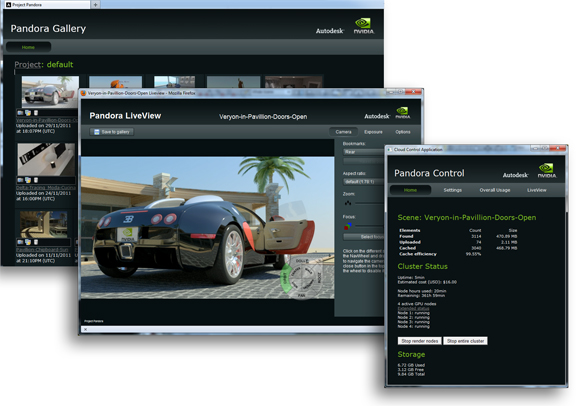Latest News
December 12, 2011
If you’re a fan of classical mythology, you might remember that, when Pandora opened the box the Gods had given her for safekeeping, she unwittingly unleashed pestilence, torment, and diseases upon mankind (Hesiod’s Works and Days). Last month, at the Venetian hotel and casino in Las Vegas, NVIDIA opened Pandora’s box, in a manner of speaking. No evidence that the GPU maker has offended the Gods in Mount Olympus again, but the company is causing quite a buzz with what Pandora’s technology can do.
Project Pandora is the joint-effort between Autodesk and NVIDIA to enable Autodesk 3ds Max users to tap into cloud-hosted Tesla GPUs to render time-consuming scenes and clips. At Autodesk University 2011 (Nov. 29-Dec 2), the technology was demonstrated right alongside NVIDIA’s newly launched Maximus workstations.
Discussing Pandora’s magic in a company blog post, Phil Miller, NVIDIA’s director of software product management, said, “Project Pandora harnesses the compute power of a GPU cluster on any Flash-capable PC running 3ds Max and [NVIDIA’s rendering engine] iray. This allows 3ds Max users to add virtual dual-GPU rendering machines to their workflow on demand. Unlike ‘batch’ network rendering, where each machine renders one frame, Project Pandora coordinates the entire cluster to accelerate the current frame. Jobs that used to take over a day can now be done in under an hour by leveraging dozens of cloud nodes.”
Typically, the computing power available in mobile tablets and consumer laptops would be inadequate to render a complex 3D scene in a timely fashion, let alone interacting with the scene in real-time. But the use of remote GPUs over a web browser can make this possible, as demonstrated in an early prototype of Pandora. “At AU 2011 Las Vegas, we’re using tablets powered by the NVIDIA Tegra 2 mobile processor to show to navigate photorealistic scenes, composed of millions of polygons, in under a minute,” Miller wrote.
Neither Autodesk nor NVIDIA has specified dates for Pandora’s public availability.
Subscribe to our FREE magazine, FREE email newsletters or both!
Latest News
About the Author
Kenneth Wong is Digital Engineering’s resident blogger and senior editor. Email him at [email protected] or share your thoughts on this article at digitaleng.news/facebook.
Follow DERelated Topics







